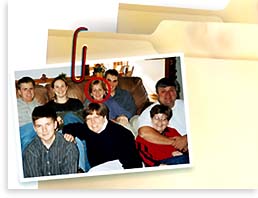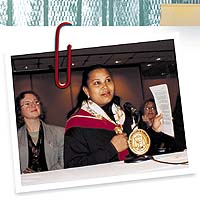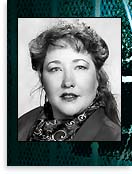

Innocent families are trapped in an Orwellian nightmare in which children are wrested from homes and forced into a system that could endanger their lives — while parents are powerless to do anything but watch.
by Mark Stout and Gail M. Armstrong

utch and Kitral Chaplin of Missouri will never again take their rights for granted. It would be difficult to find more well-meaning parents than the Chaplins, devout Christians who home-schooled their daughter Abbey, providing her a sound education and a loving family environment. In fact, charges later leveled against the Chaplins about Abbey’s care served only to verify the lengths to which they went to ensure their daughter was raised in the best possible manner.
The Chaplins’ nightmare began on June 25, 1998, when they answered a knock at the door and found themselves facing a highway patrolman, a sheriff’s deputy, a deputy juvenile officer, a Department of Family Services worker and two other, unidentified people. The troop had come to take Abbey away.
The six strangers pushed their way into the Chaplin home and into the 14-year-old girl’s bedroom. When Abbey tearfully protested, she was told that if she failed to cooperate, she would be handcuffed and taken by force. Clad only in her nightclothes and a pair of shoes, Abbey was escorted from her home.
The charge used to justify Abbey’s state-sponsored kidnapping was “medical neglect.”
Nothing could be further from the truth.
A year before this episode, Abbey had been going through the trials and tribulations faced by many teens. Her parents forbade her relationship with an older boy who was using drugs. Abbey made a half-hearted suicide attempt, taking a non-fatal overdose of aspirin. The drama of that incident passed, but after several months Abbey again joined company with the wrong crowd. On June 19, 1998, she was arrested for shoplifting.
Kitral, feeling she and Butch had tried everything to keep Abbey out of harm’s way, sought help from a professional counselor. On the recommendation of a friend, she drove Abbey to Charter Hospital in Columbia, Missouri, which reportedly had a Christian-based counseling program. Kitral paid $2,500 for Abbey to stay five days at Charter. She stressed to staff that her daughter not be administered any drugs without her consent.
The following morning, Kitral received a call from a Charter psychiatrist who wanted to start Abbey on an anti-depressant drug. Kitral objected, suggesting a natural, herbal alternative. She was told that if she was going to refuse her daughter the drug, then she might as well come and take her out. Determined that a second opinion was in order, the Chaplins went to retrieve Abbey.
The first surprise was that after only a day and a half, Kitral said Charter now demanded $2,300 in addition to the $2,500 she had already paid. The second was when the psychiatrist entered the room and told the Chaplins that she would place a call to the Department of Family Services (DFS) and report the Chaplins for medical neglect if they removed Abbey from the institution.
Unintimidated, Kitral and Butch took Abbey home and began looking for another counselor. However, within hours, DFS called, demanding the Chaplins come to their offices, or DFS would come to their home. The Chaplin family showed up at DFS the following day. After being interviewed, a DFS worker said that the family, in Kitral’s words, “should go home and do nothing, as [the worker] would be able to help us find a counselor for Abbey faster than anybody else.”
The Enforcers
The truth in the DFS statement was that they would move quickly. Behind the Chaplins’ backs, they secured a court order allowing them to charge into the Chaplins’ home the next day and whisk Abbey back to Charter.
Their daughter now a ward of the state, Kitral and Butch had no say in her treatment. Abbey was put on a combination of two psychotropic drugs which another doctor told the Chaplins was extremely dangerous. Dr. Ann Tracy, one of the leading national authorities on psychotropic drugs, later confirmed that statement by informing the Chaplins the combination could be lethal.
After 12 days in Charter, Abbey was released — but not to her parents. She was sent to a foster home where it is likely she would have stayed indefinitely had a worker at the home not intervened, telling the DFS the only reason Abbey was depressed was because she needed to be home.
On April 26, 1999, the DFS’s charges against the Chaplins for medical neglect were dismissed and the agency was finally out of their lives.
Authorities who have reviewed the Chaplins’ case concur that there is no excuse for their ordeal. It was Kitral who brought her daughter to Charter in the first place, clearly a move made with the best interests of the child in mind. Further, as Kitral asked, “If a family can’t even take their child to a doctor for a second opinion, what has this country come to?”
A National Tragedy
Though she lives over 1,000 miles away from the Chaplins, Angela Castillo has asked the same question. Her story began when her 7-year-old son began to defend himself against the teasing and taunting of other children in school. When he began fighting back, school counselors insisted he take a psychotropic drug.
Shortly after starting the drug, Anthony began complaining that he felt ill. That soon became an obvious understatement with the appearance of such symptoms as dizziness, falling asleep in class, bouts of vomiting and an increasingly yellow hue to his skin.
Angela took him to two medical doctors. Both told her to take the boy off the drug, which she did out of concern for her son’s health. Even so, the school therapist insisted Anthony continue the drug. Angela refused.
Two days later, on December 11, 1997, two policemen and two social workers showed up at Angela Castillo’s door and took all four of her children away, the youngest being only five months old. The police, said Angela, “said it was for ‘neglecting to give a prescription order to my son.’”
A lengthy fight ensued for more than a year to regain custody of her children.
Freedom learned of dozens of similar cases during its investigation.
“A most appalling pattern is emerging,” said Suzanne Shell, author of Profane Justice: A Comprehensive Guide to Asserting Your Parental Rights and founder of the Family Advocacy Center, which fights for the rights of parents falsely accused of abuse or neglect. “They take the children first and ask questions later.”
While instances do exist where children are abused and must have their safety and well-being ensured, child protective service agencies enter homes 3,000 times a day. Shell and other family advocates say that in many cases, children are removed from their homes with no evidence of abuse or neglect.
The state agencies and local laws they act on follow the federal Child Abuse Prevention and Treatment Act of 1974 (which created the Child Protective Services [CPS] system) and its subsequent amendments. Since the law passed, child abuse reports have increased sharply. The Government Accounting Office stated in 1997 that over a nine-year period beginning in 1988, reports of child abuse or neglect to CPS agencies across the United States rose 41 percent, reaching 3,195,000 by 1997.

|
 |
Abbey Chaplin (circled) reunited with her family and friends (including parents Kitral, middle, and Butch, far right).
The Chaplins’ nightmare began on June 25, 1998, when they answered a knock at the door and found themselves facing a highway patrolman, a sheriff’s deputy, a deputy juvenile officer, a Department of Family Services worker and two other, unidentified people. The troop had come to take Abbey away.
|
 |
Targeting the Vulnerable
“In today’s society, many parental practices are being falsely interpreted as abuse — including home schooling, discipline, spanking, Bible reading, and even breast feeding,” Shell said. “This results in the prosecution of many innocent parents.”
Shell and others point to a pattern of violations of rights of American parents, starting with the most vulnerable members of society — although the trend has been growing over the past two decades from predominantly poverty-level and minority families to middle-class families from the white majority.
According to attorney Michael Humiston, who is representing parents in a class-action lawsuit against the state of Utah for the unjustified loss of custody of their children, the system counts on three factors: poverty, ignorance and isolation.
“For decades, blacks, Hispanics and Indians have been victims of this system,” Humiston said. “Around 1987 the child welfare industry found that these traditional underclasses weren’t sufficient to supply the million children per year it takes to feed the machine, so Congress vastly expanded the funding and intrusive nature of the child welfare laws.”

|
 |
Angela Castillo revealed her story at a public hearing.
Two policemen and two social workers showed up at Angela Castillo’s door and took all four of her children away, the youngest being only five months old. The police, stated Angela, “said it was for ‘neglecting to give a prescription order to my son.’”
|
 |
He charged that “The first contact by caseworkers is in effect a probe to ascertain the family’s vulnerability on these bases.”
According to the available statistics of the American Public Welfare Association (APWA), compiled from 31 states under the Voluntary Cooperative Information System, roughly 40.4 percent of the children in foster or substitute care in 1990 were black — more than triple the contemporary ethnic proportion of 12.3 percent of the U.S. population.
“From my own experience, the poor, uneducated, strongly religious, and ethnic groups perceived to be without power are targeted for state intervention that generates federal fund claims for the state,” said James Roger Brown, sociologist with the Sociology Center in Little Rock, Arkansas. The center has extensively investigated abuses of the Child Protective Services system in different states.
Financial Incentives
Although the system was established as a safety net for the child, some groups and individuals have found it easy to manipulate for their own ends.
Possessing powers not granted to any other government agency, and able to operate in secrecy — provisions intended to be for the best interest of the child — CPS agencies have become a tool of revenge for some: the psychiatrist who wishes to overcome parents who object to proposed treatment; the mental health center that has discovered it can obtain a higher rate of reimbursement if the child is made a ward of the state; the ex-spouse seeking revenge or custody of the children.
Family advocates say money is also a major factor in the number of children entering the system.
Family advocates say money is also a major factor in the number of children entering the system.
|
|
Across the country, federal and state funds combined for foster care can range from $400 to as much as $2,000 per month per child, depending on his or her deemed therapeutic or “emotional” needs. The monies go to state-run foster services and state-contracted private foster care agencies, both of which in turn pay for their own support and foster families under their charge. Foster parents of children deemed to have emotional needs can end up with as much as $1,000 per month per child and take as many as four children.
Further, the national Adoption and Safe Families Act of 1997 provides for bonuses to states of as much as $4,000 per child above the number of children adopted the previous year. Another bonus of up to $2,000 can be added for each child who is designated as having special needs. While the law is intended to increase the number of foster children placed in permanent homes, it also provides powerful incentives to boost the number of children needlessly removed from their homes.
continued...




![]()
![]()

![]()
![]()

![]()
![]()

